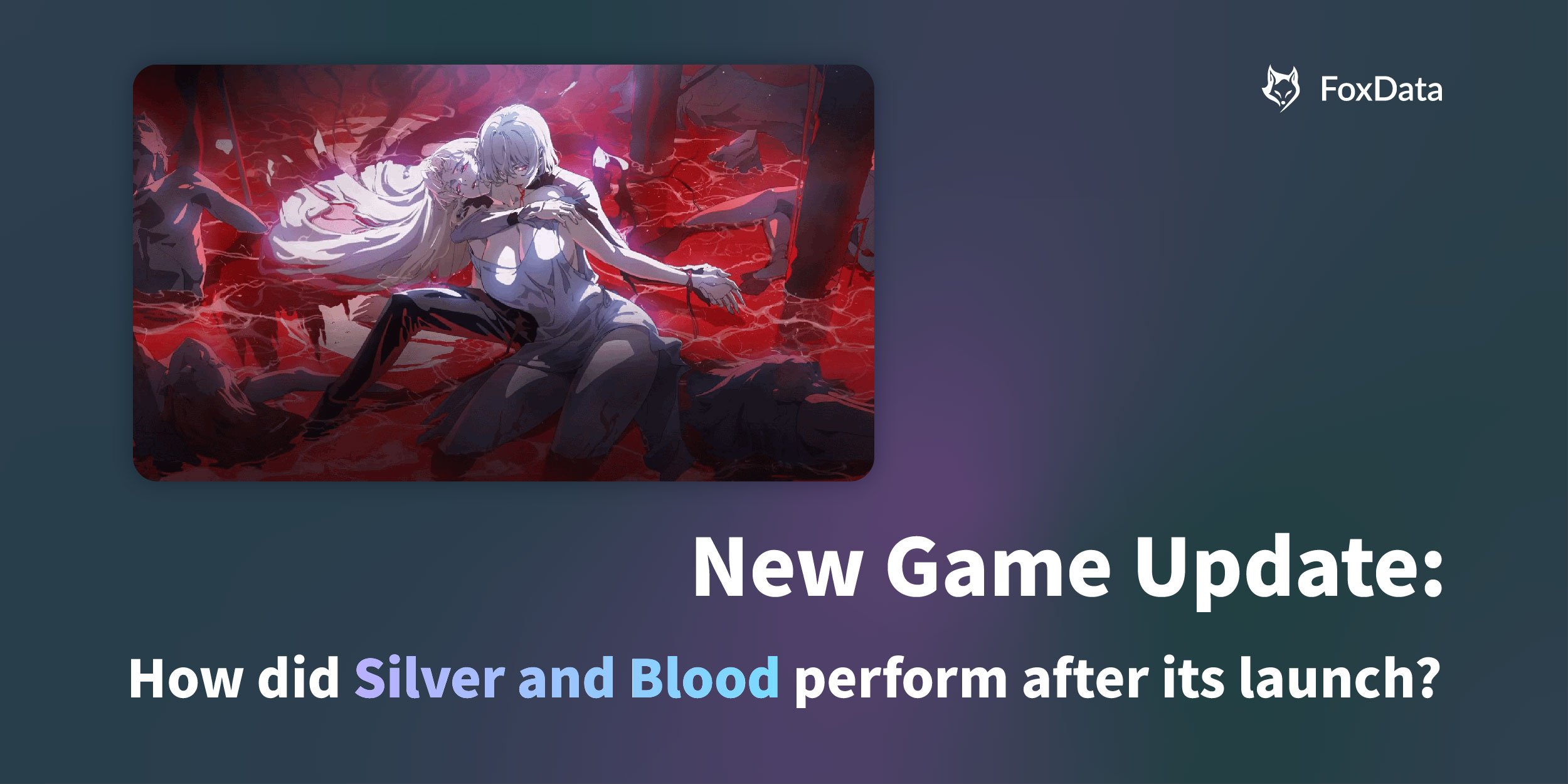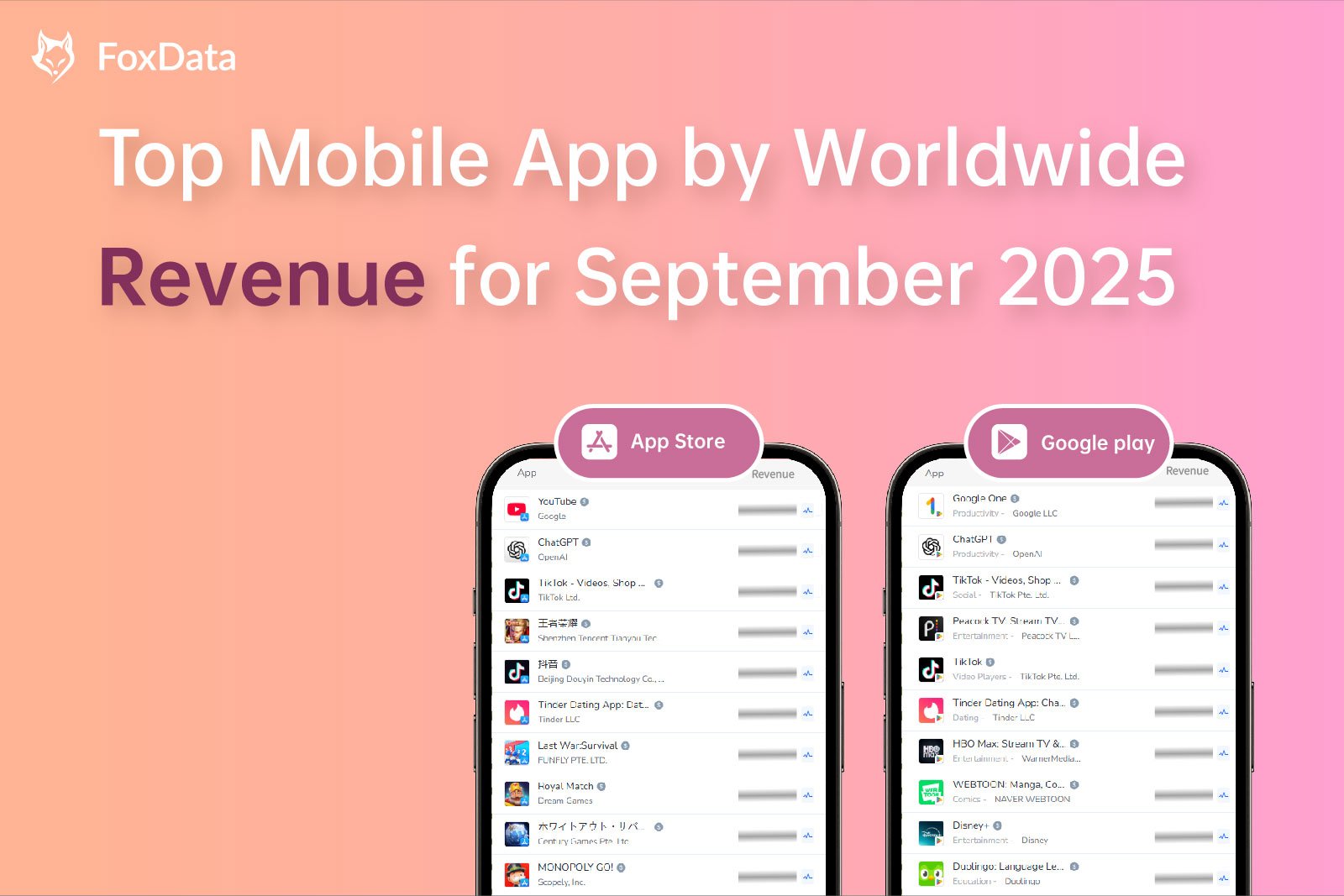New Game Update: How Did Silver and Blood Perform After Its Launch?

Entering 2025, as the market becomes increasingly saturated, user growth slows, and content innovation becomes more homogenized, the anime-style mobile game sector (commonly referred to as “二次元” or ACGN-style games) is undergoing a shift from rapid expansion to strategic consolidation. Amid challenges in monetization, user ecosystems, global expansion, and the next stage of technological integration, developers are now faced with the question: how can the genre evolve?
Launched on June 26, 2025, Silver and Blood is a new ACGN-themed mobile game developed and published by Moonton, a studio known for its global success with the MOBA title Mobile Legends: Bang Bang (MLBB). Upon release, the game quickly climbed to the top of the Chinese iOS free game chart.
Thanks to Moonton's mature global publishing infrastructure, Silver and Blood has also seen a strong overseas debut: it reached No.1 and No.2 on the iOS free charts in Korea and Japan respectively, while also securing top-three positions in Hong Kong, Taiwan, Macau, and parts of Southeast Asia.
Silver and Blood have demonstrated outstanding performance in East Asia and Southeast Asia.
This article offers a comprehensive review of Silver and Blood’s current performance and potential challenges based on its artistic direction, gameplay structure, global rollout, and initial player feedback.
Art Direction & Worldbuilding: Exploring Style Differentiation in a Market of Homogeneity
As a newly launched title in 2025, Silver and Blood stands out in an increasingly formulaic ACGN mobile landscape by adopting a relatively rare combination of vampiric themes and gothic fantasy aesthetics. The game builds its world around two opposing factions: Silverstar Technologies and the Crimson Flame Beacon, avoiding the overly familiar “end of world” or “savior narrative” arcs. Instead, the plot emphasizes ideological conflict embedded in contrasting values such as technocratic order versus individual devotion.
According to content in early access and official materials, In the timeline of the game’s history, late autumn of 1353 marked the emergence of the Black Blood Plague that devoured the continent. A young man named Noah from a small town was sentenced to execution by burning by the church on charges of infection. However, he was unexpectedly rescued by a Night Clan maiden. Subsequently, Noah became a pivotal figure in the Night Clan’s lunar expedition back to their homeland, initiating an adventure centered on the struggle for dominance among the divine, humanity, and the Night Clan factions.
Early players have praised Silver and blood’s multi-perspective storytelling and interwoven character allegiances, describing the narrative as a departure from traditional hero-centric frameworks.
In terms of visual style, Silver and Blood embraces its non-mainstream setting by combining watercolor textures with semi-thick brushstrokes, culminating in a consistent gothic aesthetic across its character design, in-game environments, and lighting.
With a visual palette dominated by gray-blues, deep reds, and inky blacks, the game relies heavily on shadows and high-contrast visuals to craft a subdued yet atmospheric tone. According to the production team, the art direction was inspired by classic gothic games such as Castlevania: Order of Ecclesia (2008), and the final aesthetic was finalized after multiple visual iterations and targeted user testing.
The character designs consciously avoid overtly commercialized or highly stylized features, opting instead for a stronger sense of material logic and cultural layering. Uniforms feature heavy tailoring and metallic elements, while subtle control over facial expressions adds to the sense of restraint and sophistication, presenting a “world-fantasy fusion” rather than default anime commercial templates.
In addition, the game features a notable amount of 2D hand-drawn animation sequences embedded in its early campaign storylines—nine major cutscenes in the first two chapters alone, used mainly to establish pivotal narrative beats and emotional transitions. These sequences align with a serialized anime format in story rhythm and are supported by original illustrations, coordinated voice acting, and background music, significantly enhancing immersion in the early game.
Overall, Silver and Blood gains its initial standout value through its distinct visual aesthetic and thematic direction. While its art style may not appeal to all mainstream ACGN audiences, its consistency in tone and bespoke artistic execution creates a strong foundation for subsequent gameplay and system experiences, carving out a niche touchpoint in a content-saturated market.
Players of "Silver and Blood" are highly satisfied with the game's visuals, storyline, and voice acting, as evidenced by the AI Review Summary feature provided by FoxData.
Gameplay & Systems: Finding a Balance Between Accessibility and Complexity
Compared to many other data-oriented or stamina-gated mobile RPGs, Silver and Blood takes a more restrained approach to gameplay systems. The development team intentionally focused on lowering mechanical burden while prioritizing narrative rhythm and strategic pacing. Key implementations include the removal of a stamina system, a “Sync-level” character progression model, and clear segmentation between main quests, side content, and auxiliary modes.
One of the most notable features is the complete elimination of stamina or any energy-related gating system. Players can replay most main and side content at will without consuming finite resources. This fundamentally breaks the conventional “daily quest–energy cost–resource reward” loop and shifts pacing control from mission timers to user agency. It allows players to engage with the story and combat at their own pace rather than being driven by reward cooldowns.
Complementing this is the “Sync Progression” system, which enables all characters not in the main leveling team to automatically sync to the fifth-highest level in the player's current roster. Paired with resource pooling options, it mitigates duplicate investment and eliminates the traditional grind required to raise new characters independently. The design significantly lowers the barrier for experimenting with team comps and incentivizes collection over optimization pressure.
Combat-wise, Silver and Blood features semi-automated tactical RPG mechanics: players execute team setups in pre-battle formation, while characters perform auto-attacks in battle, with player-controlled ultimate (AoE) skills executed via cooldown mechanics. Enemy types, skill synergy, and positional logic contribute to a meaningful degree of tactical flexibility beyond mere stat scaling.
In sum, Silver and Blood does not attempt to invent a completely new genre structure; rather, it implements selective optimizations within an established ACGN gameplay template. From stamina removal to streamlined growth systems, the goal appears to be enabling more attention on storytelling and tone rather than repetitive progression mechanics. As stated by the producer in interviews, they hope players spend more time “with the characters and their stories” than in routine resource loops.
Based on Time Spent data from FoxData, although Silver and Blood does not fully align with traditional anime-style mobile games in terms of gameplay, it still reflects the strong user stickiness typically seen among fans of the genre.
However, this design decision also implies trade-offs in conventional KPI frameworks. Limited daily logins and softened numerical barriers may lead to flatter short-term performance metrics. Whether the narrative and characters alone can sustain engagement and drive long-term commercial conversion remains a major point of uncertainty for later stages of the title’s lifecycle.
In mid-to-heavy content-focused mobile games, a Day 1 retention rate exceeding 40% typically indicates that early users have a strong appreciation for the initial art design, music, narrative, and UI/UX.
Global Strategy: From Style Experimentation to International Deployment
From a commercial perspective, Silver and Blood aims not only to differentiate itself in form and structure—it also reveals clear ambitions toward global distribution. Post-launch data shows that the title quickly climbed iOS download charts not only in China but also across Japan, Korea, Taiwan, Hong Kong, and Southeast Asia, reflecting a strategic “global-parallel launch + regionalized operations” playbook.
This synchronicity stems from Moonton’s accumulated expertise in overseas deployment. Having built a mature global release infrastructure through MLBB, the studio has experience in language localization, community segmentation, and precision marketing. These capabilities have now migrated to a wholly different genre in Silver and Blood’s rollout.
At launch, the game supports fully localized Chinese, English, Japanese, and Korean versions, with dialogue and UI adapted to subtle tonal differences per market. For instance, the Japanese voice and dialogue style leans more into anime-like rhythm and emotional nuance, while the English build favors direct and character-specific stylization. The game also features multiple renowned Japanese and global voice actors to enhance cross-regional accessibility.
Beyond translation, localized community operations were activated pre-launch. Dedicated social media accounts for each major language are actively maintained, with region-specific moderation, event promotions, and user feedback mechanisms in place. This “regionalized publishing with local engagement” model, previously proven in MLBB, continues here but faces different audience behavior and monetization norms.
Preliminary data shows strong uptake in Asia-Pacific ACGN strongholds like Japan, Korea, and Taiwan. However, adoption in Western markets remains less predictable, partly due to the game’s Eastern-stylized aesthetic and character archetypes that favor emotional subtlety over commercial appeal. Community-based viral marketing and narrative-forward campaigns may help bridge this, but mid-to-late stage retention and in-app economy conversion will be key tests in non-Asian gaming regions.
Challenges and Uncertainties
Despite early achievements in art direction, mechanical innovation, and initial global deployment, Silver Requiem—as a content-driven, mid-core anime-style mobile game—faces a number of significant challenges as it enters a longer-term operational phase. These include content production sustainability, gameplay retention structure, monetization scalability, and increasingly competitive genre dynamics.
The most immediate concern is content sustainability. The campaign leans heavily on narrative arcs and animated cutscenes to retain player interest. Given the high production cost of such content and players’ demand for narrative regularity, maintaining consistent quality and release cadence will test the team’s capacity. In the ACGN genre, delays or drops in story updates often correlate directly with declines in engagement and spending.
Additionally, the game’s deliberately “lightweight design philosophy” has sparked feedback from some players around shallow progression depth and limited gameplay challenge. While systems like Sync-Leveling and stamina-free exploration ease entry, they also leave experienced users questioning the long-term mastery loop. Core combat mechanics and advanced modes have yet to establish high visibility in community content, and whether the game will cultivate distinctive gameplay influencers remains an open question.
On the global front, despite multiple language versions and localized content, Silver and Blood’s stylistic leanings remain deeply rooted in East Asian narrative and visual culture. This may result in selective market enthusiasm, particularly in North America or Western Europe, where mobile gaming trends skew toward casual formats or competitive monetization loops. The need for stronger community embedding and platform-native adaptation will likely define the next phase of overseas expansion.

On social media, players are criticizing the overly exaggerated bust designs of traditional anime-style female characters.
From a monetization standpoint, the title currently relies on standard character gacha (pull) mechanics and cosmetic skins, with no clearly differentiated spending loop at launch. Given the game’s runtime bypasses routines like stamina burnout or heavy stat progression, drivers for high-value ARPU (Average Revenue per User) remain weak. Designing monetization that respects player pacing while sustaining development velocity is a major open question.
Lastly, the competitive environment for narrative-heavy, visually polished anime mobile games is intensifying. Between 2024 and 2025, contenders such as Wuthering Waves, Reverse: 1999, and Arknights sequels are aggressively investing in narrative animation and atmospheric worldbuilding. Without distinct long-term positioning or executional edge in updates, there’s mounting pressure for Silver Requiem to retain a defensible niche amidst this crowd.
In conclusion, Silver and Blood’s early success rests largely on its hybrid strengths—a contrarian setting, controlled storytelling, and accessible onboarding. But to truly convert early traction into durable market value, the title must navigate a convergence of challenges: managing release pace, expanding gameplay depth, cultivating recurring monetization models, and maintaining emotional resonance across geographies.
📚 Recommended reading:






